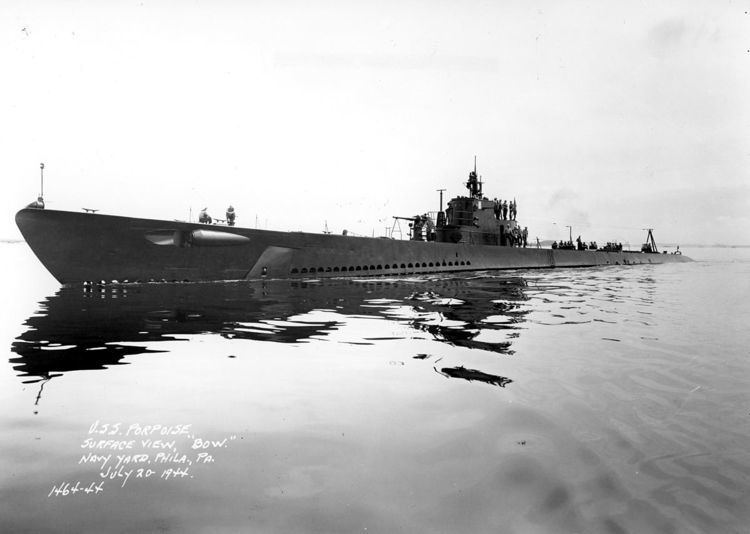Preceded by Cachalot class Built 1933–1937 | ||
 | ||
Builders | ||
The Porpoise class were submarines built for the United States Navy in the late 1930s, and incorporated a number of modern features that would make them the basis for subsequent Salmon, Sargo, Tambor, Gato, Balao, and Tench classes. Based on the Cachalots, enlarged to incorporate additional main diesels and generators, the Portsmouth boats were all riveted while the other boats were welded. In some references, the Porpoises are called the "P" class.
Contents
Design
In general, they were around 300 feet (91 m) long and diesel-electric powered. Displacement was 1,934 tons submerged for the first four boats, 1,998 tons for the later ones.
The goal of a 21-knot fleet submarine that could keep up with the standard-type battleships was still elusive. The relatively high surfaced speed of 18 knots (33 km/h) was primarily to improve reliability at lower cruising speeds. A major improvement essential in a Pacific war was an increase in range from Perch onwards, nearly doubling from 6,000 nautical miles (11,000 km) to 11,000 nautical miles (20,000 km) at 10 knots (19 km/h). This allowed extended patrols in Japanese home waters, and would remain standard through the Tench class of 1944.
Although it proved successful with improved equipment beginning with the Tambor class of 1940, the diesel-electric drive was troublesome at first. In this arrangement, the boat's four main diesel engines drove only electric generators, which supplied power to high-speed electric motors geared to the propeller shafts. The engines themselves were not connected to the propeller shafts. For submerged propulsion, massive storage batteries supplied electricity to the motors. Problems arose with flashover and arcing in the main electric motors. There was also a loss of 360 hp (270 kW) in transmission through the electrical system. The Winton Model 16-201A 16-cylinder diesels also proved problematic, and were eventually replaced with 12-278As.
Five of the class received an additional pair of external bow torpedo tubes, probably early in World War II: Porpoise, Pike, Tarpon, Pickerel, and Permit. The original Mark 21 3 inch (76 mm)/50 caliber deck gun proved to be too light in service. It lacked sufficient punch to finish off crippled or small targets quickly enough to suit the crews. It was replaced by the Mark 9 4 inch (102 mm)/50 caliber gun in 1943-44, in most cases removed from an S-boat being transferred to training duty.
Ships in class
The Porpoise class consisted of the following three subclasses:
P-1 Type
P-3 Type
P-5 Type
Service
Following participation in exercises from 1937, all but three of the ten Porpoise class were forward deployed to the Philippines in late 1939. In October 1941 most of the front-line submarine force, including all sixteen Salmon and Sargo class boats, joined them. The Japanese occupation of southern Indo-China and the August 1941 American-British-Dutch retaliatory oil embargo had raised international tensions, and an increased military presence in the Philippines was felt necessary. Fortunately, the Japanese did not bomb the Philippines until 10 December 1941, so almost all of the submarines were able to get underway prior to an attack. Two of the class were lost in Southeast Asian waters in early 1942, and another two were lost near Japan in 1943. By early 1945, all six surviving boats had been transferred to New London, Connecticut for training duties. Of these, four were used postwar as decommissioned reserve training submarines until they were scrapped in 1957.
